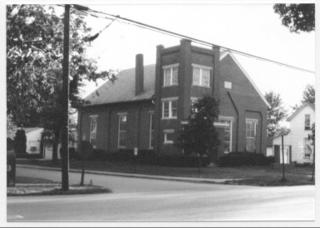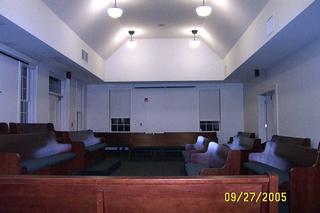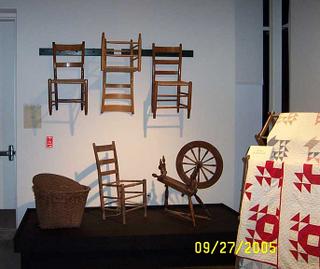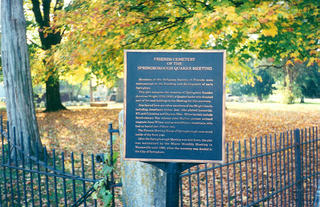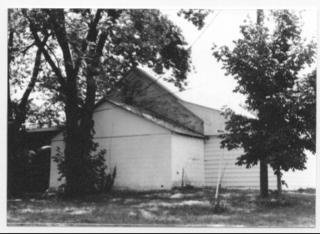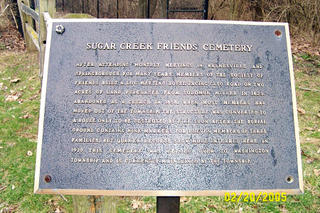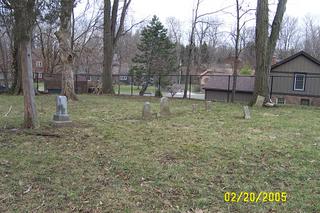The story below illustrates how the early Quaker pioneers and ministers were very human and it opens a window upon the realities of establishing a new monthly meeting in the wilderness.
(Story taken from “Settlement of Miami Monthly Meeting, Ohio” (Friends’ Intelligencer & Journal, Volume 45, 1888, pp. 577-579) by R. H (Robert Hatton)
Of the pioneer settler of Miami Meeting few memoranda now exist. They were more particularly acquainted with the use of the axe than that of the pen. The observation of Joseph Cloud, one of them, probably conveys their feelings correctly: “When I die, Just say Joseph Cloud is dead.” While not destitute of literary ability, the necessity of a living overshadowed other considerations excepting religious duties. . . Roland Richards came from Virginia with a large family of daughters and I think, one son. The daughters were Abigail, who married Ezekiel Cleaver, Hannah married David Holloway; Mary married William Mills, Sarah married Judah Foulke; Katharine married Isaac Mills, Sidney married _____.
Roland Richards and his wife Lydia were advanced in years when they arrive he being an acknowledged minister, and sitting at the head of the meeting. He was one of primitive appearance, and adhered to the broad pronunciation. A stranger called to see him and inquired if “Mr. Ro-land Richards lived there,” when the old man replied, “No, Ro-land Richards don’t, but plain Row-land Richards does.” He was tenacious of his views of discipline. A young couple, somewhat related, proposed marriage, to which he strongly objected, but Friends generally assented, the parties not being nearer than third or fourth cousins. When the time for its accomplishment came, Roland continued the sitting long and then rose and observed that he supposed there was couple present to be married and he supposed they might as well proceed to say the ceremony, and then he walked out, not being willing to sanction the marriage by his presence. He was doubtless sincere in his views and his daughters were all an honor to their education. He went to Ohio from Virginia, but did not long survive, his widow living several years after him.
Between him and his fellow minister, Joseph Cloud, the want of congeniality of sentiment was evident. Joseph was from one of the Carolinas, and imbued with some jealousy, which then as well as now had influence against those of a northern or eastern State. Joseph was rustic in appearance and home surroundings, while Roland Richards possessed more of the manner and habits of the Virginia gentleman. Of their ministry probably no fault could be found, each filling his allotment with true dignity, and being careful to mind his own calling. But in regard to business in the Society a difference of view was often found, accompanied with bluntness of expression. On one occasion Joseph gave his view of the subject before the meeting, at some length, and when he sat down Roland arose and sonorously asked, “And who is this that darkeneth counsel with words without knowledge?” to which Joseph quickly answered, “If I have darkened counsel do thou unfold it.”
Roland Richards has the distinction of being the first Quaker schoolmaster in the meeting school in Waynesville.
*****************************************
Roland Richards (b. October 29th, 1728 ~ d. May 21, 1815) son of Samuel, was the father of 15 children, 5 died in childhood, 3 boys survived and 7 girls survived. An examination of the Richards family will illustrate the inter-relationships among the large pioneering families and also the migration routes taken by early settlers.
The Richards family journey began from Philadelphia, Pa., then to Virginia, then to Ohio and then to Indiana. Roland Richards was married twice. His first wife was Mary Miles (b. October 25th, 1727 at Radnor, Delaware, Pennsylvania) (see, The Encyclopedia of American Quaker Genealogy, Vol. VI. (Virginia) [Genealogical Publishing Company, 1994], p. 604). They had two children together: Abijah Richards (b. May 23, 1753-d. March 1819) and Ebenezer Richards (b. July 18, 1754). Little is known about Ebenezer who died in 1775. He probably did not marry. Abijah Richards married Esther Daniel, Jr., the daughter of William and Esther Graham Daniel of Loudon Co., Va.) at Goose Creek Monthly Meeting, Va. on 3 mo. 29th. On 9th mo. 24th day, 1787 they moved their membership to South River Monthly Meeting in Virginia 1787 (see, The Encyclopedia of American Quaker Genealogy, Vol. VI (Virginia) [Genealogical Publishing Company, 1994], p. 695). Eventually Abijah and Esther settled in Columbiana County, Ohio, Middletown Monthly Meeting, via Westland Monthly Meeting in 1801. Their seven children were: Samuel, Esther, Abijah, Mary, Rowland and Eli (see, The Encyclopedia of American Quaker Genealogy, Vol. IV. (Ohio) [Genealogical Publishing Company, 1994], pp. 55-56, 653).
Roland Richards married Lydia Townsend, daughter of Charles, on 9 mo. 8th 1763 and had 13 more children. Seven of the daughters married and moved west with their husbands:
1. Abigail, b. 10 mo. 7th 1764, married Ezekial Cleaver (7 mo. 4th 1787) and settled in Waynesville. Ezekial Cleaver of Frederick co., Va., the son of Ezekiel and Mary, later of Gwynedd, Montgomery Co., Pa, deceased, married at public Meeting at Crooked Run, Abigail Richards, daughter of Rowland and Lydia Richards of Frederick Co., Va. on 7 mo. 4th 1787. They had four children: Mary (1789), Abigail (1792), Ezekial (1794) and Peter (1796) (see, The Encyclopedia of American Quaker Genealogy, Vol. VI. (Virginia) [Genealogical Publishing Company, 1994], p. 593. Information about the marriage certificate of Ezekial and Abigail Cleaver can be found on ancestry.com (Frederick County, Virginia, Hopewell Friends History (database online). Orem, UT: Ancestry.com, 1997. Original data: Joint committee of Hopewell Friends. Hopewell Friends History 1734-1934: Frederick County, Virginia: Records of Hopewell Monthly Meetings and Meetings Reporting to Hopewell. Strasburg, VA: Shenandoah Publishing House, 1936).
2. Samuel, b. 11 mo. 27th 1765 ~ d. 12th mo. 29th 1787
3. Elizabeth, b. 11 mo. 13th 1767 ~ d. 2 mo. 17th 1788
4. Susannah, b. 10 mo. 16th 1769 ~ d. 2 mo. 9th 1788
5. Eli, b. 9 mo. 16th 1771
6. Hannah, b. 1 mo. 31st 1774, married David Holloway (6 mo. 23rd 1771 ~ d.12 mo. 31st 1847) on 3 mo. 12th 1794 and settled in Waynesville. The following is taken from an article, “Miami Monthly Meeting, Part I” by Robert Hatton printed in the Miami-Gazette (March 15, 1876):
David Holloway (b. June 23rd, 1771 Stafford, Va.~ d. December 31st, 1847 in Richmond, Indiana) was his (Roland Richard’s) son-in-law, having married (March 12th, 1794 at Hopewell Monthly Meeting) his second daughter Hannah (b. January 31st, 1774 in Philadelphia), who was an excellent Friend. David had much of a consequential air about him, and in the earlier part of his time was tenacious of plainness, bringing his children to meeting, etc., and would close his store on meeting days. It is related of him that when suspenders were first brought about, his sons, then in their teens, procured some, which their father no sooner discovered, that he took them away and burned them. Subsequently, the youngsters procured flax and twisted it into a substitute. On this becoming known to David he destroyed them and reprimanded his children. This produced a dislike to the society and when they reached majority they left Friends and married out from among them. No doubt David was perfectly sincere in his views, as he never adopted the condemned suspenders in his own wardrobe. About the year 1815 he moved to Cincinnati and the general depression of the commercials affairs in 1819-20 added to some unfortunate endorsements resulted in the loss of most of the acquirements of years of active labor. In 1822 he removed to a farm in Indiana, about four miles east of Richmond, where he remained a few years; and after several other changes closed his life from a cancer. His very superior wife survived him several years.
Hannah and David Holloway had seven children: Dayton [sometimes spelled, Daten] (b. 1795), Lydia (1796), Margaret (1799), John (1801), Abigail (1803), Hannah (1807) and David P. Holloway (1809). David P. Holloway, the grandson of Roland Richards, was destined to be a Congressman, see: http://bioguide.congress.gov/scripts/biodisplay.pl?index=H000730.
7. Lydia (1), b. 3 mo 24th 1776 ~ d. 7 mo. 28th 1777
8. Townsend, b. 3 mo 25th 1778 ~ d. 3 mo. 5th 1788
9. Mary, b. 9 mo. 12th 1780, married William Mills, son of early settler James Mills who came to Waynesville with Abijah O’Neall from Bush River Monthly Meeting and settled in Waynesville. William Mills (d. 2 mo 2nd 1859) married Mary Richards (d. 3 mo. 6th 1837). They had 10 children: Elizabeth (1803), Rachel (1805), Isaac (1807), Roland R. (1809), James (1812), Lydia (1814), Deborah (1817), Franklin (1819) and twin girls, Ruthanna and Ruth (1820) (see, The Encyclopedia of American Quaker Genealogy, Vol. V. (Ohio) [Genealogical Publishing Company, 1994], p. 100. Mary Richards Mills (buried on 3 mo. 7th, 1837) and her son Franklin (buried on 2 mo. 21st 1837) are buried in the Hicksite Friends Cemetery in Waynesville, Fifth Row, Numbers 8 and 9.
10. Lydia (2), b. 10 mo. 18th 1782, married John Mullin (b. 4 mo. 7th 1752) on 10 mo. 9th 1799, his second marriage and settled in Waynesville. By his first wife, Catherine Haines, John Mullin had eleven children. By his second wife, Lydia Richards, he had one son Samuel Mullin who was born September 12th, 1800 in Frederick Co., Va. and died on February 28th, 1870 in Warren County, Ohio (Richard Haines and His Descendants: A Quaker Family of Burlington County, N.J. since 1682 by John Wesley Haine (Boyce, Va.: Carr), p. 2:74.
11. Sarah, b. 8 mo. 28th 1784, married Judah Faulke and eventually settled in Waynesville area. Judah Faulke, the son of Joshua and Hannah of Warren County, Ohio married at Miami Monthly Meeting, Sarah Richards, the daughter of Roland and Lydia Richards of Warren Co. on 6 mo. 15th 1808 (see, The Encyclopedia of American Quaker Genealogy, Vol. V. (Ohio) [Genealogical Publishing Company, 1994], pp. 56 and 115. Judah and Sarah must have settled for a number of years in eastern Ohio or Western Pennsylvania since on 2 mo. 24th 1819 Judah and Sarah Faulke were received on certificate back to Miami Miami Monthly on 2 mo. 24th 1819, along with their children: Amelia, Cadwallader, Jesse Mary (male), Grace, Silas and John) (see, The Encyclopedia of American Quaker Genealogy, Vol. V. (Ohio) [Genealogical Publishing Company, 1994], p. 56. It is reported that Jesse M. Foulke, the son of Judah and Sarah of Highland Co., Ohio was married in Clear Creek Meetinghouse to Mary Baker, the daughter of Amasa and Sarah of Highland County, Ohio (see, The Encyclopedia of American Quaker Genealogy, Vol. V. (Ohio) [Genealogical Publishing Company, 1994], p. 302). The Faulkes had settled in Highland County.
12. Catherine (b. 7 mo. 30th 1786 ~ d. 7 mo. 24th 1860 in Warren Co., Ohio) married Isaac Mills (d. April 2nd, 1860 in Warren Co. Ohio), brother of William Mills (see above, who married Catherine's sister, Mary Richards) and settled in Waynesville. Isaac, son of James and Lydia Mills (who traveled to Waynesville from Bush River Monthly Meeting with Abijah O’Neall) of Warren Co., Ohio married Catherine Richards, the daughter of Roland and Lydia Richards of Warren Co., Ohio on 11 mo. 18th 1807 (see, The Encyclopedia of American Quaker Genealogy, Vol. V. (Ohio) [Genealogical Publishing Company, 1994], p. 100.) They became members of Springboro Monthly Meeting and from there transferred their membership to Duck Creek Monthly Meeting in Indiana on 10 mo. 30th 1827 (see, The Encyclopedia of American Quaker Genealogy, Vol. V. (Ohio) [Genealogical Publishing Company, 1994], p. 973). They had 7 children: Sarah, Eli, Samuel, Roland R., Noah, Mary Ann and Joel T. Mills. An unnamed child of Isaac Mills is buried in the Hicksite Friends Graveyard in Waynesville on 4 mo. 30th, 1842 Second Row, #47).
13. Sidney (sometimes spelled Sitnah), b. 10 mo. 5th 1789, married Jacob Paxon on 10 mo. 15th 1806 at Miami Monthly Meeting and settled in Waynesville (see, The Encyclopedia of American Quaker Genealogy, Vol. V. (Ohio) [Genealogical Publishing Company, 1994], p. 108 and 115).


